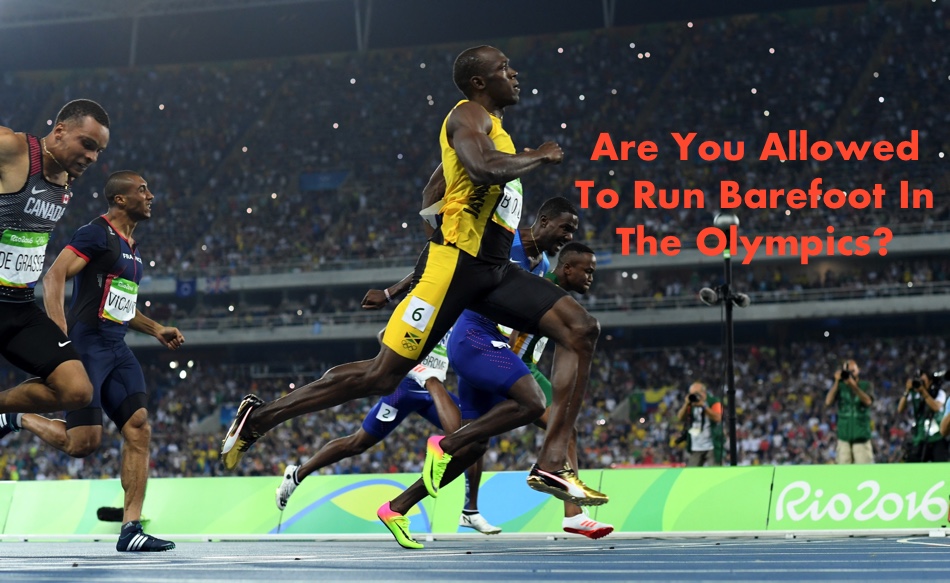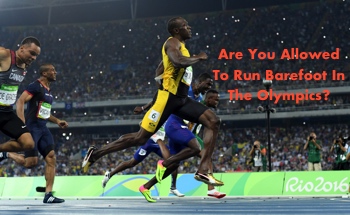
Rio Olympics 2016 Photos: Getty Images
Are You Allowed To Run Barefoot In The Olympics?
Table of Contents
With all the talk about and posts about barefoot running, barefoot marathons, barefoot in the snow, it was only a matter of time before the super competitive side of sports come into focus. How this relates in the wider, more elite side of sports is something I want to answer in great detail. The rise in popularity of barefoot I have already written about check it out here.
So, are you allowed to run barefoot in the Olympics? You are allowed to run barefoot at the Olympics yes. The rules of the International Olympic Committee’s (IOC) Olympic charter and by extension the International Association of Athletics Federations (IAAF) rules allow you to run barefoot if you choose to. It is however not a common sight anymore.
This is the case most especially at shorter distances like the 100m or 200m races. At the elite level, competing barefoot in those shorter distances will make you less competitive. It is more common at longer distances like the marathon and the 10,000m races than shorter races.
Let’s go into more details, and I will walk you through the details, so we know for sure that we are up to date.
What The International Olympic Committee (IOC) Rules Say
I went off to have a look, did some digging. Heres what I found.
My first port of call was the Olympic Charter in force from the 15th September 2017; you can download it here.
But before you rush off there’s more: let me save you the bother of downloading it unless you really want to read all of it and sift through.
Here is an excerpt of what we need.
Bye Rule 45 & 46:
Bye Law 45 Section: 1.3 The sports which may be included in the sports programme of the Games of the Olympiad are: 1.3.1 The sports, governed by the following IFs, which are currently included in the programme, namely: –
- International Association of Athletics Federations (IAAF)
- World Rowing Federation (FISA)
- Badminton World Federation (BWF)
Bye Law46: Role of the IFs in relation to the Olympic Games each IF is responsible for the control and direction of its sport at the Olympic Games. All elements of the competitions, including the schedule, field of play, training sites and all equipment must comply with its rules. For all such arrangements, the OCOG must consult the relevant IFs.
The IOC
For our purposes, we are only interested in the IAAF because this is for barefoot running. Let me give you some context, the IOC oversees everything for the Olympics but leaves the individual sporting event included in the Olympics to the governing bodies and the International Federations (IF). They, in turn, set the overarching rules that the athletes’ train to and abide by. So as long as it does not run contrary to the spirit of the games or is a special ruling, it just works fine everyone knows what they are doing.
What the International Association Of Athletics Federations (IAAF) Says:
Off to the site I went to get the information but then they ask for everything but the kitchen sink to get the download. I guess I will have to take one for the team you can get it here if you want to go through the bother. Look for IAAF Competition Rules 2018-2019, in force from 1 November 2017 or whichever is relevant to you.
Ok here it is, and it even has relevant amendments to clarify what we happen to be looking for, brilliant.
CLOTHING, SHOES AND ATHLETE BIBS – RULE 143.2
Here is the Amended version new notes in bold at the bottom
Shoes 2. Athletes may compete barefoot or with footwear on one or both feet. The purpose of shoes for competition is to give protection and stability to the feet and a firm grip on the ground. Such shoes, however, must not be constructed so as to give an athletes any unfair additional assistance,
including by the incorporation of any technology which willgive the wearer any unfair or advantage. A shoe strap over the instep is permitted. Alltypes of competition shoes must be approved by IAAF.Any type of shoe used must be reasonably available to all in the spirit of the universality of athletics.
Note (i): Adaption of a shoe to suit the characteristic of a particular athlete’s foot is permitted if made in accordance with the general principles of these Rules.
Note (ii): Where evidence is provided to the IAAF that a type of shoe being used in competition does not comply with the Rules or the spirit of them, it may refer the shoe for study and if there is non-compliance may prohibit such shoes from being used in competition.IAAF
That captures it perfectly now we have that all squared away.
There no way we can have an article on barefoot running in the Olympics without a brief special mention of the barefoot hero from our recent history.
Famous Barefoot Olympic Runners
There have been quite a few, and I do have a post about the reason how barefoot running has become popular as I said earlier check it out here. For today we will stick with my top four.
Abebe Bikila
Abebe Bikila of Ethiopia won the Olympic Gold medal in the marathon at the age of 28. This was the first of two Olympic Gold medals he would win. The first was in Rome in 1960, then four years later in 1964, Tokyo Japan.
The story goes that in Rome there was a mixup at the time leading up to the race and he didn’t have access to any shoes to run with. He instantly opted to do the race barefoot.
Since his training for the Olympics just so happened to be barefoot anyway, this was not too difficult for him to do. He attracted attention at the time because he was the first East African to win a medal. Abebe Bikila set an Olympic world record time of 2:15:16.2.
Four years later in 1964 during the Tokyo Olympics, Abebe defended his title despite recovering from appendicitis in the lead up to the race.
Shivnath Singh
Shivnath Singh is one of India’s greatest long distance runners, he was known for always running barefoot with just tape strapped onto his feet. Singh represented India in the Asian games and twice at the Summer Olympics (1976 and 1980). He also placed 11th in the 1976 Olympic Men’s Marathon. He started but failed to complete the 1980 Olympic Men’s Marathon in Moscow. He was noted for running barefoot throughout his running career.
Zola Budd Pieterse
Zola Budd Pieterse as she is now known, became known for her barefoot running style, training and racing barefoot. She Ran for England in the 1984 Olympics barefoot and finished 7th clocking a time of 14:48.07. This was following the now infamous collision with She was infamous to being involved in the collision with home favourite Mary Decker.
Pehind Carappan Suppiah
P.C Suppiah as he is popularly known is a Singaporean long-distance runner who competed for his country in the 1972 Olympics barefoot. He competed in the 10,000m at the 1972 Munich Olympics. He was the first Singaporean to run under 32 minutes in the 10,000m. He began barefoot running simply because he couldn’t afford footwear as he was growing up. His Singaporean national record from 1973 of 31:19 still stands to this day.
Barefoot Running At Olympics In Recent Years
Except for the occasional occurrence in years gone by there are seldom instances of barefoot running in the Olympics. Even though the rules clearly state that you can wear shoes if you like or not. The chances of seeing this in the shorter sprint distances are slim to none in my opinion.
There is too much at stake and too much competition for an elite athlete at the country level not to have spiked shoes. In all likelihood, there will probably be a greater chance of it happening in the longer distance races like the marathon or the 10,000m as has been the case so far.
Wrap Up
Running barefoot in the Olympics is possible and allowed by the rules of the International Associaton of Athletic Federations (IAAF) as we have seen. The Olympic Committee largely take the guidance on each sport from the respective International Federation (IF). There have been a number of notable barefoot heroes in the past in the Olympics. They have come to the fore either because they have been in situations where running barefoot was either the only option available or simply a way of life.
